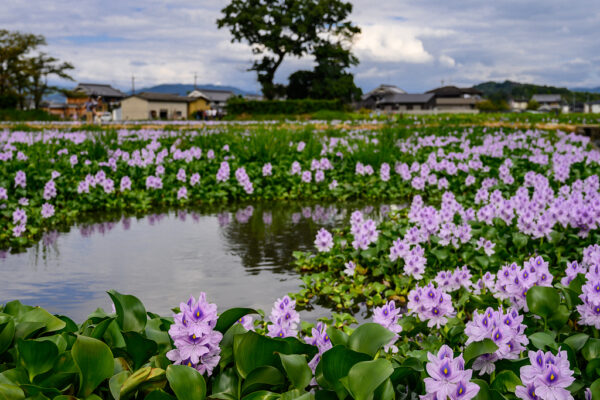Water Hyacinth

Species at a Glance
Water hyacinth (Eichhornia crassipes) is a free-floating flowering perennial that forms dense “rafts” of plant material in the water that can cover a lake surface. Its beauty makes it a popular ornamental plant for ponds; however, its fast growth makes it one of the worst aquatic weeds in the world, as it can double its population in as little as six days.
Identification
The leaves are oval, rounded, circular, or elliptical, and are arranged in rosettes on stalks that can rise 0.9 m (3 ft) above the water’s surface. They are thick, glossy, waxy green, and typically up to 15 cm (6 in) wide. The edges of the leaf are wavy, and the bases are heart-shaped, square, or rounded with dense veins.
The water hyacinth produces multiple flowers (8-15) which form in a single showy spike growing up to 30 cm (12 in) long atop a thick stalk. Each flower in the spike has six lavender-blue petals. The uppermost petal is somewhat larger with a bright yellow, blue-bordered, central spot. A three-celled capsule contains many seeds.
The stems grow up to 0.5 m (1.5 ft) long and are filled with air spaces, which give them a spongy appearance and allow them to stay afloat. Fibrous roots hang submerged beneath the floating leaves. They are dark purple to black and have a feathery appearance.
Similar Species
Water hyacinth can be confused with American spongeplant (Limnobium spongia) because of its similar looking leaves; however, American spongeplant has white roots instead of black and has slender, ridged stems instead of bulbous, inflated stems. It can also be confused with water lettuce (Pistia stratiotes), which has large, ribbed leaves and doesn’t have the showy flowers.
Habitat
This species grows in shallow temporary ponds, wetlands, marshes, sluggish flowing waters, lakes, reservoirs, rivers, and ditches of temperate climates. It can tolerate extremes in water level fluctuations and seasonal variations in nutrients, pH, temperatures, and toxins. It is not winter hardy and needs temperatures above 12°C (54°F) to survive.
Spread
Deliberate release and escape from water gardens have been major modes of dispersal. Once introduced, its high growth rate has allowed it to quickly establish and spread. It reproduces both by fragmentation and by forming plantlets at the end of a shoot that grows from the base of the stem.
Distribution
Native to South America in Brazil, water hyacinth is now found in more than 50 countries on five continents. It is believed to have been introduced to the United States in 1884 for the Cotton States Exposition held in New Orleans and was given as gifts to attendees who took it home to add to backyard ponds. By 1900 it had escaped cultivation to become a serious pest.
Environmental Impacts
Water hyacinth forms thick mats that block waterways and limit boat traffic, swimming, fishing, and other recreational activities. In drainage and irrigation canals, it impedes flow which can result in flooding and clogged pumps. Dense mats prevent sunlight and oxygen from penetrating the water column and the submerged plants below, shading out native species and reducing biodiversity.
Resources:
Ramey, V. 2001 Eichhornia crassipes. University of Florida Center for Aquatic and Invasive Plants.
Global Invasive Species Database (2016) Species profile: Eichhornia crassipes.
ImapInvasives (2021)



